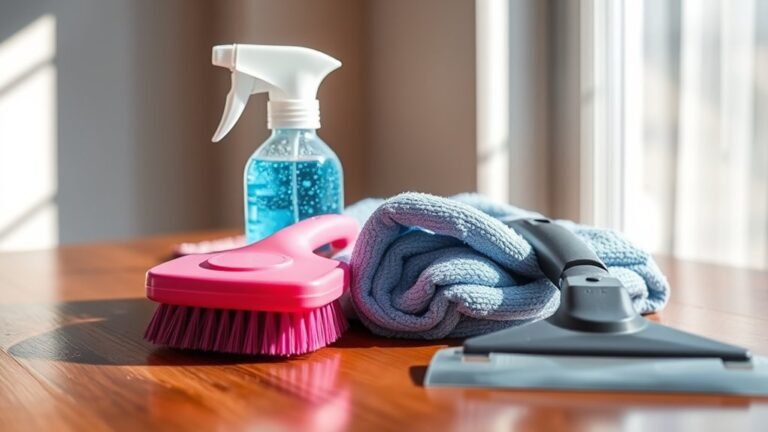How to Clean and Deodorize Your Grout
To clean and deodorize your grout, start by mixing baking soda and water into a paste, applying it to grout lines, then spray with vinegar. Let it fizz for 5-10 minutes before scrubbing with a stiff brush and rinsing clean. For tough stains, hydrogen peroxide works well. To freshen, wipe grout with lemon juice and add a drop of essential oils. Seal grout every six months to protect it. Keep going to discover more ways to maintain that fresh, clean appearance.
Understanding Grout and Its Common Issues

Grout is the material that fills the gaps between tiles, providing stability and a finished look. You’ll find that grout composition typically includes cement, water, and sometimes sand or additives for durability. This mix creates a porous surface, which, while vital for bonding tiles, leaves grout vulnerable to common stains like dirt, mold, and mildew. Because grout can absorb spills and dirt easily, it often darkens over time, losing its fresh appearance. Understanding these aspects helps you realize why regular cleaning is essential if you want to maintain freedom from stubborn stains and unpleasant odors. By knowing what grout is made of and recognizing common stains, you’re better prepared to tackle grime and keep your tiled spaces looking vibrant and fresh.
Essential Tools and Materials for Grout Cleaning
To get your grout looking fresh, you’ll need the right cleaning supplies like brushes, cleaners, and baking soda. Don’t forget protective gear such as gloves and a mask to keep yourself safe from harsh chemicals. Having these essentials on hand makes the job much easier and safer.
Must-Have Cleaning Supplies
Although cleaning grout might seem straightforward, having the right supplies can make the process much easier and more effective. To keep your grout colors vibrant and fresh, you’ll want a quality grout cleaner suited for your tile type and the cleaning frequency you prefer. A stiff-bristled brush helps you tackle stubborn stains without damaging grout lines. Don’t forget a spray bottle for applying homemade or commercial solutions evenly. Microfiber cloths or sponges work perfectly for wiping down surfaces afterward, preventing residue buildup. Finally, a bucket for mixing your cleaning solution guarantees you can adjust strength depending on how often you clean. With these must-have supplies, you’ll enjoy total freedom in maintaining grout that looks great without hassle or damage.
Protective Gear Essentials
Having the right cleaning supplies is just part of the equation; protecting yourself during grout cleaning is equally important. Before you get started, slip on a pair of protective gloves to shield your hands from harsh chemicals and abrasive scrubbing. These gloves give you the freedom to work confidently without worrying about skin irritation. Don’t forget safety goggles, either—they guard your eyes from splashes and airborne particles that can cause discomfort or injury. With these essentials, you can tackle grout with ease and peace of mind. Taking these simple precautions lets you clean effectively while staying safe, so you can enjoy a fresh, deodorized space without compromise. Safety gear isn’t just a choice—it’s your ticket to freedom and control in every cleaning session.
Preparing the Area for Grout Cleaning

Before you start cleaning, make sure to clear any items from the surfaces around your grout to avoid damage or mess. Next, gather all your cleaning supplies so everything’s within reach. Being prepared will make the process smoother and more efficient.
Clear Surrounding Surfaces
Since grout cleaning can be messy, you’ll want to clear the surrounding surfaces to protect them from splashes and spills. Move any rugs, mats, or fragile items out of the way to prevent accidental damage. Cover countertops and nearby fixtures with old towels or plastic sheets to avoid stains from your cleaning solution options. Understanding grout discoloration causes helps you choose the right cleaner without harming adjacent surfaces. Remember, some solutions might be strong enough to damage tiles or finishes if they come into contact. Taking these simple steps provides you the freedom to clean confidently and efficiently, knowing your space is safeguarded. Preparing your area this way guarantees your grout cleaning process is smooth and stress-free, leaving you with fresh, deodorized grout and a protected environment.
Gather Cleaning Supplies
While protecting your space is important, you’ll also need to gather the right cleaning supplies to tackle your grout effectively. Different grout types—whether epoxy, cement, or sanded—respond best to specific cleaning techniques, so choose your tools carefully. Grab a stiff-bristle brush or an old toothbrush to scrub those stubborn lines. Have a bucket ready for mixing your cleaning solution—vinegar for cement grout or a mild detergent for epoxy works well. Don’t forget gloves to protect your skin and a spray bottle for easy application. A microfiber cloth or sponge will help wipe away residue without damaging surfaces. By assembling these essentials upfront, you set yourself free to clean with confidence and efficiency, making grout restoration a hassle-free task.
Using Baking Soda and Vinegar for Natural Cleaning
One of the simplest and most effective ways to clean and deodorize grout naturally is by using a mixture of baking soda and vinegar. Baking soda benefits include gentle abrasion and odor absorption, while vinegar properties like acidity break down grime and kill bacteria. Together, they offer you a powerful, chemical-free cleaning solution that lets you reclaim your space with ease.
| Schritt | Ingredient | Zweck |
|---|---|---|
| 1. Make Paste | Baking soda | Scrubs and deodorizes |
| 2. Apply Paste | On grout | Targets dirt and stains |
| 3. Spray | Vinegar | Reacts to lift grime |
| 4. Let Sit | 5-10 minutes | Allows chemical action |
| 5. Scrub & Rinse | Brush & water | Cleans and refreshes grout |
Try this natural method to enjoy fresh, clean grout without harsh chemicals.
Applying Hydrogen Peroxide for Tough Stains

When you’re dealing with tough grout stains that baking soda and vinegar can’t fully tackle, hydrogen peroxide is a great next step. Its powerful oxidizing properties make it ideal for hydrogen peroxide applications targeting stubborn grime. Simply apply the hydrogen peroxide directly onto the stained grout lines, letting it sit for about 10 minutes. This gives it time to break down deep-set dirt and discoloration. Afterward, scrub with a stiff brush and rinse with warm water. This method is one of the most effective tough stain solutions you can use without harsh chemicals. Using hydrogen peroxide lets you regain clean, bright grout while maintaining control over the products you bring into your home—helping you keep things fresh and free on your own terms.
Deodorizing Grout With Lemon Juice and Essential Oils
Although cleaning grout removes stains, it doesn’t always eliminate lingering odors. To truly refresh your space, try deodorizing grout with lemon juice and essential oils. The lemon juice benefits go beyond brightening grout—it naturally cuts through grime while leaving a fresh, citrus scent. Mix fresh lemon juice with your choice of essential oil blends, like lavender or eucalyptus, to amplify the deodorizing effect and add a personal touch. Apply this mixture directly onto the grout lines, let it sit for 10-15 minutes, then scrub gently and rinse. This simple, natural method frees you from harsh chemicals and fills your home with invigorating aromas. With lemon juice and essential oils, your grout will look clean and smell as fresh as freedom itself.
Preventative Measures to Keep Grout Clean Longer
After deodorizing your grout with lemon juice and essential oils, you’ll want to keep it fresh and clean for as long as possible. One key step is grout sealing, which creates a protective barrier against dirt and stains. Pair this with regular maintenance, like quick spot cleaning, to prevent buildup. Here’s a simple guide to keep your grout in top shape:
| Action | Frequency | Nutzen |
|---|---|---|
| Grout sealing | Every 1-2 years | Prevents moisture & stains |
| Spot cleaning | Weekly | Stops dirt from settling |
| Deep cleaning | Monthly | Removes tough grime |
| Ventilation | Daily | Reduces mold & mildew |
Tips for Maintaining Fresh and Stain-Free Grout
Keeping your grout fresh and stain-free doesn’t have to be a chore. With the right grout maintenance tips and stain prevention strategies, you can enjoy a clean, vibrant space without feeling tied down by constant upkeep. Here’s how you can maintain your grout effortlessly:
- Seal regularly: Apply a high-quality grout sealer every six months to create a protective barrier.
- Clean spills immediately: Don’t let stains set; wipe up liquids and dirt as soon as they appear.
- Use gentle cleaners: Avoid harsh chemicals that can erode grout; opt for pH-neutral solutions.
- Ventilate well: Keep your area dry and aired out to prevent mold and mildew buildup.
Häufig gestellte Fragen
Can Grout Cleaning Damage Tile Surfaces?
Imagine your tile surface is a delicate canvas—you wouldn’t want harsh chemicals to become the villain, right? When you’re cleaning grout, using the wrong grout cleaning products can scratch or dull that precious tile surface. To keep your freedom to enjoy spotless tiles, always choose gentle, tile surface protection-friendly cleaners. This way, you protect your space’s beauty without sacrificing its integrity or your peace of mind.
How Often Should Grout Be Professionally Sealed?
You should consider grout sealing frequency to be about every one to two years, depending on your tile’s exposure to moisture and wear. Keeping up with grout maintenance tips, like regular cleaning and quick spill cleanup, helps extend the seal’s life. Sealing keeps your grout protected and looking fresh, giving you freedom from constant worry about stains or damage. Stick to this schedule, and your grout will stay in great shape longer.
Are Steam Cleaners Safe for Grout?
They say, “A stitch in time saves nine,” and that applies here. Steam cleaners offer great advantages, like deep cleaning without harsh chemicals, making them safe for grout when used properly. You’ll enjoy easier grout maintenance tips since steam loosens dirt and kills bacteria effectively. Just be sure not to overuse steam on older or damaged grout to avoid weakening it. With care, steam cleaning lets you keep your freedom to enjoy a fresh, clean space.
Can Bleach Be Used on Colored Grout?
You probably shouldn’t use bleach on colored grout because it can strip away the color and cause discoloration. Instead, try bleach alternatives like baking soda and vinegar or hydrogen peroxide, which are gentler and still effective. For easy grout maintenance, regular cleaning with these alternatives helps keep your grout fresh without risking damage. That way, you’re free to enjoy vibrant tiles without worrying about harsh chemicals ruining the look.
What Causes Grout to Crack or Crumble?
Grout deterioration causes often include moisture damage, improper mixing, or shifting tiles. When grout cracks or crumbles, it’s usually because it’s weakened over time or wasn’t applied correctly. You’ll want to explore grout repair methods like removing damaged sections and reapplying new grout to keep things solid. Taking control of these repairs lets you maintain your space’s freedom and style without relying on costly professional help.






